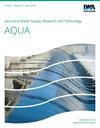基于时空图卷积网络的深度学习河流水质预测模型
IF 4.3
Q2 Environmental Science
引用次数: 1
摘要
高精度水质预报在河流污染防治中起着至关重要的作用。然而,河流水高度非线性和复杂的时空依赖性给水质预测任务带来了重大挑战。为了同时捕捉水质数据的时空特征,本文结合深度学习算法对江南平原河网区域的河流水质进行了预测。提出了一种基于图卷积网络(GCN)和长短期记忆神经网络(LSTM)的水质预测方法,即时空图卷积网络模型(ST-GCN)。具体而言,基于河站之间的时空相关性构建时空图,利用GCN提取河网中的空间特征,利用LSTM积分得到水质数据的时间相关性。采用R2、MAE和RMSE对模型进行评价,实验结果分别为0.977、0.238和0.291。与传统回归模型和一般深度学习模型相比,该模型的预测精度显著提高,稳定性和泛化能力更好。ST-GCN模型可以实现不同河段的高精度水质预测,为水环境管理提供技术支持。本文章由计算机程序翻译,如有差异,请以英文原文为准。
A deep learning model with spatio-temporal graph convolutional networks for river water quality prediction
High-precision water quality prediction plays a vital role in preventing and controlling river pollution. However, river water's highly nonlinear and complex spatio-temporal dependencies pose significant challenges to water quality prediction tasks. In order to capture the spatial and temporal characteristics of water quality data simultaneously, this paper combines deep learning algorithms for river water quality prediction in the river network area of Jiangnan Plain, China. A water quality prediction method based on graph convolutional network (GCN) and long short-term memory neural network (LSTM), namely spatio-temporal graph convolutional network model (ST-GCN), is proposed. Specifically, the spatio-temporal graph is constructed based on the spatio-temporal correlation between river stations, the spatial features in the river network are extracted using GCN, and the temporal correlation of water quality data is obtained by integrating LSTM. The model was evaluated using R2, MAE, and RMSE, and the experimental results were 0.977, 0.238, and 0.291, respectively. Compared with traditional regression models and general deep learning models, this model has significantly improved prediction accuracy, better stability, and generalization ability. The ST-GCN model can achieve high-precision water quality prediction in different river sections and provide technical support for water environment management.
求助全文
通过发布文献求助,成功后即可免费获取论文全文。
去求助
来源期刊
CiteScore
4.70
自引率
0.00%
发文量
74
审稿时长
4.5 months
期刊介绍:
Journal of Water Supply: Research and Technology - Aqua publishes peer-reviewed scientific & technical, review, and practical/ operational papers dealing with research and development in water supply technology and management, including economics, training and public relations on a national and international level.

 求助内容:
求助内容: 应助结果提醒方式:
应助结果提醒方式:


